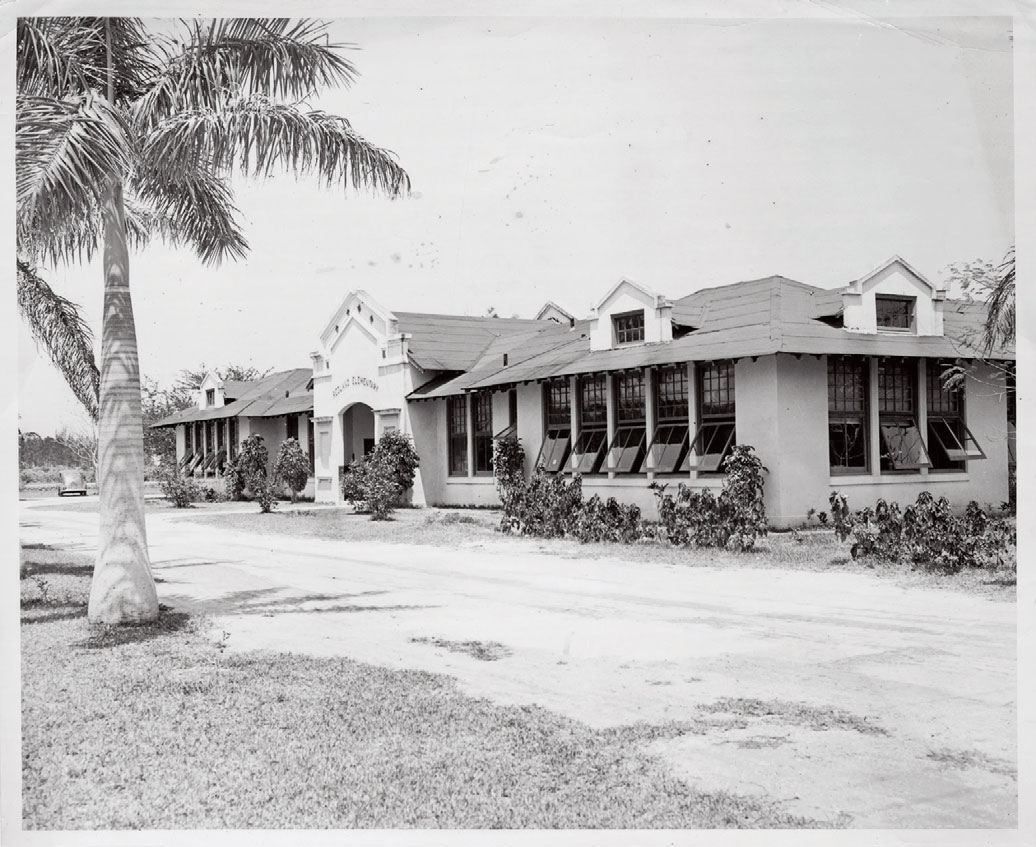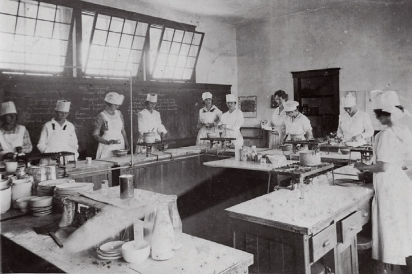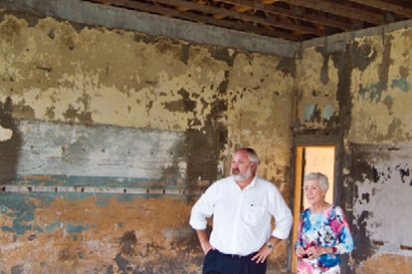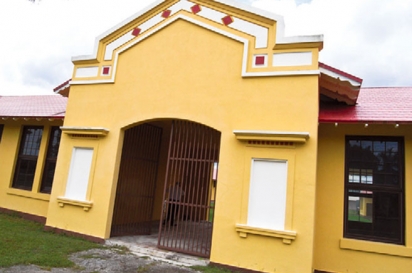New Life for the Redland Farm Life School
100 years later, a historical school remains true to its mission to be a center of agricultural learning and a hub for this rural South Florida community.
The Redland Farm Life School sports a tidy paint job, a pristine terra cotta metal roof and modern windows. But the interior classrooms are bare, their flaking walls a textured road map of decades of plaster, paint and blackboards. The school has been vacant for many years, but there are big plans underway to restore this beloved building to its roots.
In 1916, this handsome new school, on SW 248 St., across the street from and just west of Knaus Berry Farm, was the pride of the pioneer Redland community. Farm Life, the second largest rural consolidated school in the country, had classrooms for grades one through twelve, consolidating seven other schools in the region – Goulds, Eureka, Modello, Princeton, Murray Hill, Silver Palm and Redland. For the first time, children were transported by bus to classes, which followed the regular curriculum and also one for rural students.
After the Civil War, schools called Farm Life schools were set up where girls learned cooking, sewing and homemaking skills and boys learned vocational agriculture classes,” says historian Bob Jensen of the South Florida Pioneer Museum, the nonprofit group that has taken the Farm Life School project under its wing. “There was a home ec room with stoves and sewing machines, to teach preserving and cooking.” But Farm Life School was much more than a school, says Jensen. “It was a community center. It was expanded and they built an auditorium.”
Here, everyone gathered for holiday fairs, elections, dances, agricultural meetings. “When I was in school, dances were held there, sports – everything that went on in the Redland area went on at that school,” recalls Barbara Hanck of the South Florida Pioneer Museum. The property also served as a playground for the neighborhood, says Tom Blocher of Knaus Berry Farm. “Not only did most of the Knaus family attend both elementary and junior high at Redland, it was an extension of their backyard, for them, and neighboring children.”
Everything changed for that close-knit community – and all of South Florida – on August 24, 1992, when Hurricane Andrew came ashore in Homestead. Like many buildings in its path, the Farm Life School was severely damaged. “The school was not usable,” says Hanck.
“The School Board built a replacement school to the north.” Farm Life School was slated for demolition.
Tear down the beloved school? Not if the community had its way. “Locals objected,” says Jensen. They came up with a plan: Get the School Board to convey the title to the county, then the nonprofit South Florida Pioneer Museum, a 501(c)(3), would lease the property, and apply for grant money needed to restore the building. Thanks to efforts from then-county commissioner Katy Sorenson and her aide, Gabriele Marewski, who now owns Paradise Farms, the title was transferred. The nonprofit raised enough money to install impact-resistant windows, fix the roof and make structural repairs.
THE VISION
Enter Charles LaPradd, the county’s agricultural manager – and a former student at Farm Life School. In 2007, LaPradd joined local farmers and agricultural leaders on a fact-finding mission to the Finger Lakes region of upstate New York, looking for ways to promote local agritourism. They saw how wineries, bed and breakfasts, restaurants, artisans and retail was thriving amid the agricultural backdrop. The idea of creating a culinary incubator – a facility that would allow farmers and producers to do more with what they grew – was appealing.
“We were looking for a place that would have commercial kitchen space, a welcome center, serve as a focal point,” LaPradd says. “A place where you could learn how to can, how to roast a pig.”
To put the plan together, LaPradd turned to Doug Duda, who helped create the Miami Culinary Institute, the Astor Center in New York, and other food and beverage event and education centers around the country. “Farm Life makes perfect sense. It was created to be a community center. People are passionate about it and would love to see it have a second act,” he says.
His presentation paints a picture of what the modern-day version of this venerated building would look like: “Step behind the historic portico of the 1916 Redland Farm Life School into gleaming stainless steel culinary studios bustling with farm-to-table chefs, culinary students and foodies. Find yourself freshly engaged in a 100-year-old local food movement. Redland Farm Life Culinary Center creates a certified commercial kitchen (including organic and vegetarian preparation stations), instructional stage, culinary gallery and an outdoor dining courtyard replete with native flora and fauna. It is a studio where local and visiting culinary artists can embrace tropical fruit and vegetables and create bold new flavors, juices, jellies, wines and more. It is a festival gathering space for hundreds to celebrate unique ingredients like lychees, jackfruit and sapodillas. It is a stage where Miamians interact in the “performance” of a recipe that will survive over time beyond its immediate sensory pleasure to tables where the art of food speaks to history, culture, ethnicity and its origins – the Redland.”
Duda says the key to success is creating something that works for everyone. Take the commercial kitchen and local farmers: “What to do with all those avocados, tomatoes? When it’s out of season for one group, it’s in season for others,” he says. It’s a big benefit for the small farmer who cannot afford to spend $50-100K to install a commercial kitchen, says Bee Heaven Farm’s Margie Pikarsky, on the center’s advisory committee. “Many of us may have a seasonal product which comes in only once a year, and it doesn’t make sense to set up a facility on-farm to accommodate short use.” The center’s visitor center/gift shop would also provide an outlet for farm products – jellies, jams, sauces – and promote Redland Raised Fresh from Florida produce brand, especially useful for tourists and visitors.
For consumers, Duda envisions in Farm Life a modern educational aspect that echoes the home ec classes that once took place in the classrooms – recreational cooking classes. Making the project work financially is, of course, a priority. Duda sees corporate sponsors playing a large role. Users would pay to rent space. Professional courses, an agriculture camp for children, and launching new products could generate revenue. “We have to find the mix that makes it work financially. There are lots of moving parts to this, lots of people in the conversation.”
Those people include community leaders, like Miami-Dade Commissioner Daniella Levine Cava, who is “delighted to work with the Pioneer Museum to develop a visitors welcome and farm-to-table enterprise center at the historic Farm Life School,” and Debbie Brady of the Dade Farm Bureau. “We think we can be the Napa of South Florida,” she says.
There’s a long way to go. Jensen says the next step is a county business plan expected in the fall that will enable the group to apply for grants and seek private funding. Planners also hope to use Farm Life School’s centennial in 2016 to boost awareness, starting with a Founders Dinner fundraiser slated for Feb. 13, 2016. The event is expected to attract those who attended the school and supporters in the community. It will also convey the message that the Redland Farm Life School is not forgetting its roots as it moves into the future, says Barbara Hanck. The new plan to establish it as a culinary center will be “a modern-day fulfillment of its original mission as a farm life school.”
Farm Life School Through the Years
Archival images from the South Florida Pioneer Museum show students in action.
Editor’s note: Find out more about this project at the upcoming GrowFest! Oct. 16-17, where the South Florida Pioneer Museum will curate a historical photo exhibit of the Redland area and the Redland Farm Life School. Doug Duda, who is spearheading the Culinary Center’s design and vision, will be there to present the project. On the day of the event, $1 of each paid admission will go to the Culinary Center project.









